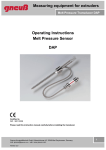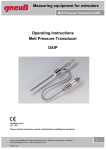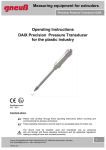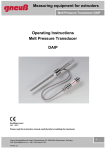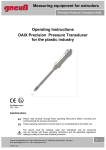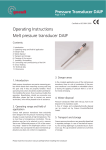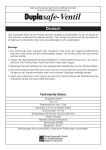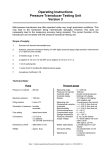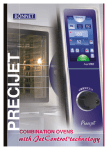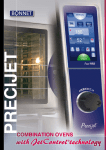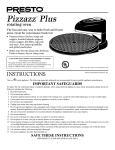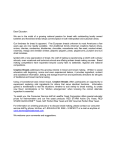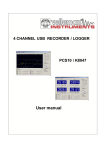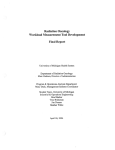Download Measuring equipment for extruders Operating Instructions
Transcript
Measuring equipment for extruders Melt Pressure Transducer DAI Operating Instructions Melt pressure transducer DAI Certified to ISO 9001:2008 Please read this instruction manual carefully before installing the transducer Gneuss Kunststofftechnik GmbH, Moenichhusen 42, 32549 Bad Oeynhausen, Germany, mail: [email protected], web: www.gneuss.com Version 2.2 1 Measuring equipment for extruders Melt Pressure Transducer DAI Contents: 1. 2. 3. 4. 5. 6. 7. 8. 9. 10. Introduction Operating range and field of application Danger areas Waste disposal Transport and storage Cleaning of the sensors Installing / Uninstalling Connecting and commissioning of the DAI Technical data Dimensions 1. Introduction Melt pressure transducers are precise measuring probes which obtain their measuring accuracy and long life span only if they are properly handled. These operating instructions should be studied carefully before installing the sensor, thus ensuring a trouble-free operation. Nevertheless, should you encounter any difficulties, please feel free to contact our service technicians, who will be pleased to be of assistance. 2. Operating range and field of application: Gneuss melt pressure transducers have exclusively been designed for the pressure monitoring of liquid, doughy or pasty materials at high temperatures. These must have a homogeneous constitution. The application area has to be selected in such a manner, that a max. differential pressure of 2 % of the measuring range – based on the diaphragm surface - is not exceeded. Any use beyond the above mentioned application area does not conform to regulations. 3. Danger areas: In the complete application area of the melt pressure transducer, there is a risk of combustion. If the pressure transducer is not installed or uninstalled correctly during the applying of pressure there is a risk of hot media emerging. 4. Waste disposal: Pressure transducers filled with mercury, have to be disposed of as hazardous waste. A free of charge and ecologically-friendly disposal can be carried out by Gneuss Kunststofftechnik GmbH. Gneuss Kunststofftechnik GmbH, Moenichhusen 42, 32549 Bad Oeynhausen, Germany, mail: [email protected], web: www.gneuss.com Version 2.2 2 Measuring equipment for extruders Melt Pressure Transducer DAI 5. Transport and storage: Gneuss pressure transducers are generally dispatched in separate packages. In case of mechanical exposure, the sensing diaphragm is protected by an aluminium cap. This cap should be screwed on at all times of storage. 6. Cleaning of the sensors In order to clean the diaphragm, the sealing surface and the process thread the sensor must have the same temperature as the plastic melting point. The diaphragm and the sealing surface can be wiped down with a soft cloth, the thread can be cleaned with a steel brush. (Do not come into contact with the diaphragm surface) 7. Installing / Uninstalling Installing On installation of the pressure transducer it is imperative to note, that the sensor bore corresponds to the dimensions mentioned below. The fitting accuracy can be checked by means of a test bolt. Prior to mounting the sensor, the thread should be covered with a heat resistant paste. Should the machinery with the sensor drilling still be at production temperature, a certain preheating period for the sensor should be taken into consideration, in order to avoid a seizing of the sensor due to thermal expansion. On mounting the transducer, it is important to note that the sensor is not screwed in at an angle and that the sensor does not fall into the bore. It is of vital importance that the force for installing the sensor must only be applied at the shaft (hexagon). Do not apply any force to the sensor head! Starting torque for 1/2-20 UNF = max. 30 Nm Starting torque for M 18 x 1,5 = max. 50 Nm Uninstalling The uninstalling of the pressure transducer has to be done in a heated up condition (plastic melting point). On removal of the sensor, please take note that the diaphragm is not brought into contact. It is of vital importance that the force for uninstalling the sensor must only be applied at the shaft (hexagon). Do not apply any force to the sensor head! 45°±1° ( d2 ) ( d4 ) ( d3 ) ( d1 ) 0,05 A A (c) (b) (a) d1 d2 d3 d4 a b c M18x1,5 ½“20UNF 2A +0,05 Ø 10,1 Ø 7,9 +0,05 Ø 16,1 +0,1 Ø 10,7 +0,1 Ø 20 +0,2 Ø 13 +0,2 6,1 –0,1 5,7 –0,1 4 –0,2 3,2 –0,2 25 19 Gneuss Kunststofftechnik GmbH, Moenichhusen 42, 32549 Bad Oeynhausen, Germany, mail: [email protected], web: www.gneuss.com Version 2.2 3 Measuring equipment for extruders Melt Pressure Transducer DAI 8. Connections and commissioning After the pressure transducer has been installed into the line, as described in section 7, the electrical connections have to be applied according to the connections indicated on page 9. Gneuss pressure transducers are equipped with high quality and robust plug connections. The connecting wire should be soldered with great care as transmission errors of signals can otherwise occur. We recommend using Gneuss prefabricated connecting wires which are available ex-stock. Pressure sensors of the type DAI are fitted with an integrated pressure amplifier, which depending on version can offer a standard signal in accordance to the pressure range. On commissioning, the sensor must be calibrated to the corresponding evaluation unit. The calibration process must be carried out when the line is heated and at zero pressure. Please proceed as described below. After successful installation and thorough heating of the pressure sensor, the zero point must be adjusted by activating the AUTO ZERO function. The AUTO ZERO function is initiated by a short connection of the corresponding wires (see wiring configuration). For the DAI version with optical AUTO ZERO initiation (DAI-…-6PA) the zero point calibration can be initiated directly at the sensor. For this, remove the screw plug near the connecting plug and direct the beam of an LED flashlight into this opening for approx. 3-5 seconds. Insert the screw plug again afterwards; it simply serves for protection against contamination and extraneous light. The protection class is not impaired even without the screw plug being fitted. The integrated amplifier will thereafter transmit the starting value of its output scale (0V at 0…10V, 0mA at 0…20mA and 4mA at 4…20mA output signal). The AUTO ZERO function is suppressed, if the output signal is more than 5 % of the maximum value. Afterwards an 80% inspection of the output signal can be performed. All corresponding lead wires need to be connected for this procedure (see wiring diagram). The pressure sensor will now supply a signal which is according to 80% of the measuring value. Gneuss Kunststofftechnik GmbH, Moenichhusen 42, 32549 Bad Oeynhausen, Germany, mail: [email protected], web: www.gneuss.com Version 2.2 4 Measuring equipment for extruders Melt Pressure Transducer DAI Electrical wiring configuration 2-Wire sensor Connector type: PT02A-10-6P. 4...20mA FAB E C D Pin Function Colour coding (Gneuss – cable) A Supply / Signal + yellow B Supply / Signal - white C free brown D Auto Zero green E 80% pink F Auto Zero / 80% grey Pin D and Pin F are utilised for the activation of the Auto-Zero function. The Zero-point is hereby merely shifted. The signal amplification is not affected, as it is shifted linear to the zero point. In order to generate the 80 % signal, pins E and F must be connected. Electrical wiring configuration 3-Wire Sensor Connector type PT02A-10-6P. 0...10V 0/4...20mA FAB E C D Pin Function Colour coding (Gneuss – cable) A Signal + yellow B Supply /Signal/Auto Zero - white C Supply + brown D free green E Auto Zero pink F 80% grey In order for the Auto-Zero function to be activated, pins E and B have to be connected with each other. Only the Zero-point is shifted. The signal amplification remains untouched, as it shifts linear to the zero-point. In order to generate the 80 % signal, pins F and B must be connected. Gneuss Kunststofftechnik GmbH, Moenichhusen 42, 32549 Bad Oeynhausen, Germany, mail: [email protected], web: www.gneuss.com Version 2.2 5 Measuring equipment for extruders Melt Pressure Transducer DAI Electrical wiring configuration 4-Wire Sensor Connector type PT02A-10-6P. 0...10V 0/4...20mA FAB E C D Pin Function Colour coding (Gneuss – cable) A Signal + yellow B Signal/Auto Zero - C Supply + D Supply / Auto Zero - E Auto Zero pink F 80% grey * white brown * green * Pins B and D are connected internally In order to activate the Auto-Zero function, pins A, C and D must be connected. Only the Zero point is shifted. The signal amplification remains in place, as it shifts linear to the zero point. In order to generate the 80% signal, pins F, C and D must be connected. Electrical wiring configuration 2-Wire sensor Version 98 Connector type: PT02A-98-P. 4...20mA A E F B D Pin Function C Colour coding (Gneuss – cable) A Auto Zero pink B free yellow C 80% / Auto Zero - * white D Supply - * green E Supply+ brown F 80% grey * Pin C und D are connected internally In order to activate the Auto-Zero function, pin A and pin C must be connected. Only the Zero point is shifted. The signal amplification remains in place, as it shifts linear to the zero point. In order to generate the 80% signal, pins F and C must be connected. Gneuss Kunststofftechnik GmbH, Moenichhusen 42, 32549 Bad Oeynhausen, Germany, mail: [email protected], web: www.gneuss.com Version 2.2 6 Measuring equipment for extruders Melt Pressure Transducer DAI Electrical wiring configuration 3-Wire Sensor Version 98 Connector type PT02A-98-P. 0...10V 0/4...20mA A E F B C D Pin Function Coulour coding (Gneuss – cable) A Auto Zero pink B Signal + yellow C Supply/Signal/Auto Zero - white D free green E Supply + brown F 80% grey In order to activate the Auto-Zero function, pins A and C have to be connected. This leads to a shifting of the zero point. The signal amplification remains in place, as it shifts linear to the zero point. The 80 % signal is generated by connecting pins F and C Electrical wiring configuration 4-Wire Sensor Version 98 Connector type PT02A-98-P. 0...10V 0/4...20mA A E D Pin F B C Function Coulour coding (Gneuss – cable) A Auto Zero pink B Signal + yellow C Signal/Auto Zero - D Supply/Auto Zero - * green E Supply + brown F 80% grey * white * Pins C and D are connected internally In order to activate the Auto-Zero function, pins A and C or D have to be connected. This leads to a shifting of the zero point. The signal amplification remains in place, as it shifts linear to the zero point. The 80 % signal is generated by connecting pins F and C or D Gneuss Kunststofftechnik GmbH, Moenichhusen 42, 32549 Bad Oeynhausen, Germany, mail: [email protected], web: www.gneuss.com Version 2.2 7 Measuring equipment for extruders Melt Pressure Transducer DAI Electrical wiring configuration 2-Wire sensor Connector type: P8 (PC06A-12-8P) 4...20mA Pin Function Colour coding (Gneuss – cable) A Supply / Signal + yellow B Supply / Signal - white C free brown D Auto Zero / 80% green E Auto Zero pink F 80% grey E free --- F free --- Pin D and Pin E are utilised for the activation of the Auto-Zero function. The Zero-point is hereby merely shifted. The signal amplification is not affected, as it is shifted linear to the zero point. In order to generate the 80 % signal, pins D and F must be connected. Gneuss Kunststofftechnik GmbH, Moenichhusen 42, 32549 Bad Oeynhausen, Germany, mail: [email protected], web: www.gneuss.com Version 2.2 8 Measuring equipment for extruders Melt Pressure Transducer DAI 9.Technical Data: Pressure range: Supply: Output signal: Calibration point: Accuracy: Maximum over load: Zero deviation with temperature Variations at the membrane:: Zero deviation with temperature Variations at the measuring head: Maximum temperature at the membrane: Maximum. Temperature at the measuring head: EMC: according to Degree of protection: See order specification 19…32 VDC 0…10 V; 0…20 mA; 4…20 mA (see order specification) 80 % of measuring range 0,50 % FSO respectively 0,25 % FSO (see order specification) 150% of measuring range 0,003 % from final value/°C 0,003 % from final value/°C 300°C with NTX-filling (W) 400°C with Hg-filling (M) 500°C with NaK-filling (N) 85 °C Electromagnetic disturbances and electromagnetic susceptibility EN 61326 IP 55 10. Dimensions For available variations see order specification Gneuss Kunststofftechnik GmbH, Moenichhusen 42, 32549 Bad Oeynhausen, Germany, mail: [email protected], web: www.gneuss.com Version 2.2 9 Measuring equipment for extruders Melt Pressure Transducer DAI Gneuss Kunststofftechnik GmbH, Moenichhusen 42, 32549 Bad Oeynhausen, Germany, mail: [email protected], web: www.gneuss.com Version 2.2 10 Measuring equipment for extruders Melt Pressure Transducer DAI Gneuss Kunststofftechnik GmbH, Moenichhusen 42, 32549 Bad Oeynhausen, Germany, mail: [email protected], web: www.gneuss.com Version 2.2 11 Measuring equipment for extruders Melt Pressure Transducer DAI Gneuss Kunststofftechnik GmbH Moenichhusen 42 32549 Bad Oeynhausen, Germany Phone: +49 (0) 5731 5307-0 Fax: +49 (0) 5731 5307-77 Mail: [email protected] www.gneuss.de Gneuss Kunststofftechnik GmbH, Moenichhusen 42, 32549 Bad Oeynhausen, Germany, mail: [email protected], web: www.gneuss.com Version 2.2 12













